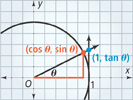13 Pull It All Together

BIG idea Modeling
You can sometimes use a function to model a real-world situation based on data from the situation.
Task 1
In one year on the Arctic and Antarctic Circles, the amount of daylight each day varies from 0 h to 24 h. Let Ar(d) and An(d) represent the amount of daylight as a function of the day of the year d at the two locations, respectively. Describe the graph of one of the functions. Then tell how the graph of the other function relates to the first graph.
BIG idea Function
You can represent functions in a variety of ways (such as graphs, tables, equations, or words). Each representation is particularly useful in certain situations.
Task 2
The diagram shows how cos θ, sin θ, and tan θ relate to the unit circle. Copy the diagram and show how sec θ, csc θ, and cot θ relate to the unit circle.
- First, find in the diagram a segment whose length is sec θ. Explain why its length is sec θ.
-
Next, find cot θ. To do this you must add to the diagram. Use the representation of tangent as a clue for what to show for cotangent. Justify your claim for cot θ.

- Find csc θ in your diagram.
BIG idea Function
You can derive some functions from a basic parent function by a particular transformation. Functions related through these transformations are called a family of functions.
Task 3
The functions f and g are periodic. You can get the graph of g by changing the amplitude and period of f, and then applying a translation. Find
Table of Contents
- 5-1 Polynomial Functions
- 5-2 Polynomials, Linear Factors, and Zeros
- 5-3 Solving Polynomial Equations
- 5-4 Dividing Polynomials
- 5-5 Theorems About Roots of Polynomial Equations
- 5-6 The Fundamental Theorem of Algebra
- 5-7 The Binomial Theorem
- 5-8 Polynomial Models in the Real World
- 5-9 Transforming Polynomial Functions





